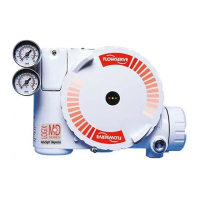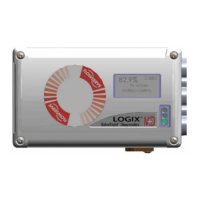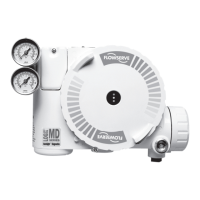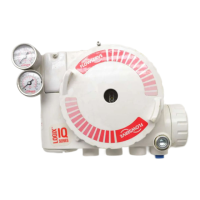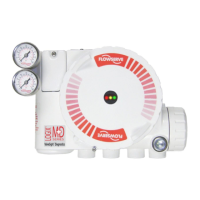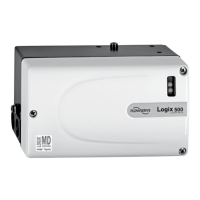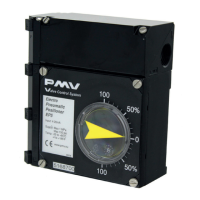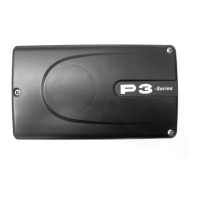23
Logix
®
420 Digital Positioner FCD LGENIM0106-07-AQ – 10/15
flowserve.com
Split Range Example:
A split range is easily configured. For example, a 4 to 12 mA signal can
be set to correspond to a 0 to 100% stroke. When the display shows
“Set 0%”, set the command input current to 4 mA. (The display will
show a low Analog to Digital Count (ADC) that corresponds to 4 mA.)
Then press the ► ACCEPT/QUICK-CAL button to set the value. Press
the ▼ Down button to move to “Set 100%”. Set the command input
current to 12 mA. (The display will show a high ADC to correspond
to 12 mA.) Again press the ► ACCEPT/QUICK-CAL button to set the
value. Select the ◄ Back Button to exit.
Signal At Closed = 20mA Example:
If the desired signal at closed is 20 mA, first set the Signal at Closed
DIP switch to 20 mA. Then perform a stroke calibration by pressing the
► ACCEPT/QUICK-CAL button for more than 3 seconds. This registers
the DIP switch settings. Then, in the Command Input Calibration menu,
when the display shows “Set 0%” it is expecting the lowest current
value. Set the input current to 4 mA. For “Set 100%”, it is looking
for the highest current value. Set the input current to 20 mA. After
accepting theses values, the positioner will interpret the 20 mA input as
0% valve position and the 4 mA input as 100%.
Calibration Dates lists the most recent date of each calibration. The
date is available only if the calibration was performed using the DTM.
10.3.5 Configuration (Positioner Tuning)
► Configuration
► Positioner Tuning
► P-Gain Open
► I-Gain Open
► D-Gain Open
► P-Gain Close
► I-Gain Close
► D-Gain Close
► Open Stroke Time
► Close Stroke Time
► Minimum Open Time
► Minimum Close Time
The Configuration – Positioner Tuning menu allows the user to
manually adjust individual tuning parameters. All tuning parameters are
automatically set to optimal values during Quick-Cal. Typically a Quick-
Cal is all that is needed for positioner tuning. See section 8 STARTUP
for more details.
1 CAUTION: Adjusting the tuning parameters will affect the respon-
siveness of the valve and could cause rapid changes to the valve
position. Notify proper personnel that the valve may stroke, and
make sure the valve is properly isolated before proceeding.
P-Gain, I-Gain and D-Gain are the proportional, integral, and differen-
tial elements of the feedback algorithm. These gains are different for
the opening and closing directions because typically responsiveness is
different in each direction.
NOTE: Only those with specific training in PID tuning algorithms should
attempt to adjust the tuning by manually changing the PID values.
Open Stroke Time is the fastest time it took the valve to stroke from
0% to 100% during Quick-Cal. Increasing this parameter will affect the
responsiveness of the valve in the opening direction.
Close Stroke Time is the fastest time it took the valve to stroke from
100% to 0% during Quick-Cal. Increasing this parameter will affect the
responsiveness of the valve in the closing direction.
Minimum Open Time and Minimum Close Time (Speed Limits) are
used to prevent the valve from moving too quickly. This can be used
when the process is sensitive to rapid flow or pressure changes. This
shows the time (in seconds) that the positioner will allow the valve to
travel a full stroke. This speed limit applies to smaller movements of the
valve too.
For example, if the Minimum Open Time were set to 20 seconds, and
the command was changed from 40% to 50%, the positioner would
move the valve at a constant rate, taking 2 seconds to complete the
move. If the Minimum Close Time was set to 0, and the command was
changed from 50% back to 40%, the positioner would make the move
as quickly as possible.
The default values are 0 seconds, meaning the positioner will move the
valve as quickly as possible.
10.3.6 Configuration (Characterization)
► Configuration
► Characterization
► MaxFlo Linear
► MaxFlo Equal %
► Valdisk Linear
► Valdisk Equal %
► ShearStream Linear
► ShearStream Equal %
► Custom
The Configuration – Characterization menu allows the user to change
the characterization of the command. This allows a better match
between the input command and the actual fluid flow through the
valve. This feature is typically used with valves that have non-linear
flow characteristics. The positioner makes a correction by applying an
adjustment to the input command according to a characterization curve.
Table 12 below shows the available characterization curve options. Each
point of the Custom curve can be adjusted using the ValveSight DTM.
To view the characterization curve options, set the Characterization
switch “Other” before performing a Quick-Cal. Otherwise, the only
option available is “Linear”. If a Quick-Cal is not possible, use the
ValveSight DTM to select the curve.
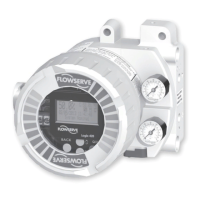
